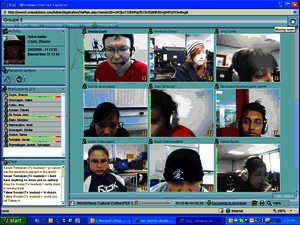The Team Teaching Project: Past, Present, Future
It’s one thing to begin a project, to try out a new idea, but how can you sustain the energy and enthusiasm, and when does a “pilot” project get its wings and mature into the real thing? Sharon Coyle (Sept-Iles Teacher), Sophie Jacmin (Vanier Teacher) and Marleigh Greaney (Vanier IT Rep) were discussing the key ingredients needed for project longevity. Our pilot project, The Sept-Iles Vanier Team Teaching Project is winding down its third year, and a five year plan has been submitted for further funding from Entente Canada-Quebec. It time to stand back and take stock!
What Are the Significant Factors for Project Longevity?
- Marleigh Greaney thinks the people behind the project are highly significant as to whether it will be around in a year or two.
- Other factors include administrative support and encouragement, and both Vanier and Cegep de Sept-Iles have backed their teachers with overt appreciation for what is being accomplished as well as IT support through acquiring equipment and liberating technicians.
- The interest of the larger community plays its part; several articles, including one of the first by Norm Spatz of Profweb, have been published about the project, and Coyle and Jacmin put together workshops for the AQPC three years running (Including this spring! Come take part!) and have shared their project at the IT fair, a REP-TIC meeting, and several pedagogical days. These presentations help build enthusiasm, in the community and for the teachers involved, but they also create a venue for reflective practice.
- By writing and talking about the project, teachers involved work through issues and challenges that arise in every learning context. The participants need to be getting something out of their investment of time and energy, and in the Team Teaching project, one of our power sources comes from the collaboration that goes on behind the scenes. For most of the teachers involved, this is the reason they stay with it; the human connections, the sharing of practices, resource ideas, learning scenarios – this is a gold mine.
- Louise Paul of the Entente Québec Canada has noted that another longevity factor is growth potential, which this project has demonstrated by taking on more teachers, more courses and more colleges.
- Last, but not least, is the IT aspect. Web 2.0 is the new mantra, and we are riding the wave of interest with a project that gets students and teachers from disparate ideologies together to learn in the synergetic soup of internet communication.
A Quick Overview of the Project during the First Two Years
The project began with the concept of “Team Teaching” at a distance with two teachers sharing real class time using internet communication systems such as Skype, iChat, Via, DecClic and Google Documents. This year the guiding concept transformed into “Mentoring” which involved widening the circle to six teachers, and therefore opening more classes. Our five year plan has the moniker of the Janus Project and involves three colleges; the intention is to add Gaspesie des Iles. Also planned is a travelling DEC component for twenty Vanier students, who would have the opportunity to partake in “regional studies” by spending their third session in either Sept-Iles or the Gaspasie.

A VIA Session in Progress.
To give you an example of the kind of learning scenarios we are looking for with this project, imagine you were sitting in on one of our best sessions this term. It was an hour long Via exchange supported by activity slides and PowerPoints uploaded ahead of time and featuring invited guests, young Muslim women who wear the Hijab head scarf. Students from Caroline Chwojka’s and Sharon Coyle’s Humanities World Views classes were able to ask questions and have a discussion about clothing, customs, attitudes, and feelings in a non-threatening environment. Students from the region and students from the city came away from the experience with a broader view. We have the possibility of changing the world 60 people at a time! Via provides a multi-faceted on-line communication tool that allows auditory and visual modes and includes a shared workspace with a variety of interesting tools such as the status bar and survey options. Web 2.0 tools such as Via open up unlimited possibilities for intellectual exchanges.
(A much more detailed article about this experience is linked here.)

Via provides a multi-faceted on-line communication tool.
A “pilot” project is, by definition, trying out something new, and in some way, although we are finishing our third year, the Team Teaching project keeps evolving (get it e-volving!) in a way that makes the label stick. The teachers involved are getting clearer on what kinds of learning activities lend themselves best to Via or iChat (Virtual Window) sessions, what kinds of content support meaningful on-line exchanges, and what kind of timing needs to be laid out (how often, how long, what variety of exchanges works best). Perhaps we can consider that we have earned our wings when the project supports the participation of new teachers with clear procedural and pedagogical advice and attracts experienced teachers who might have been hesitant about using new technologies, but who do not want to be bystanders in the benefits of collaboration. It is wonderful to envision a future that includes a team teaching community thriving on a variety of levels throughout the Quebec Cegep community and even beyond.

